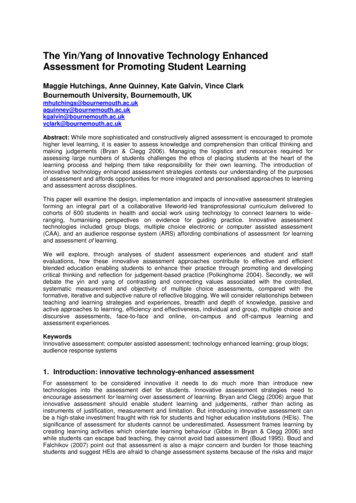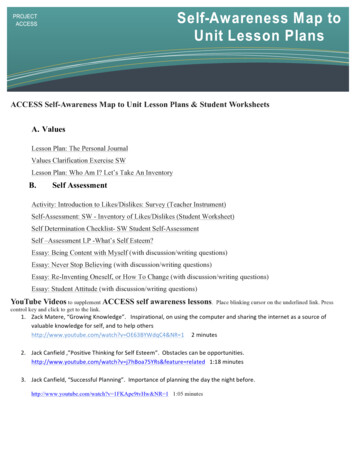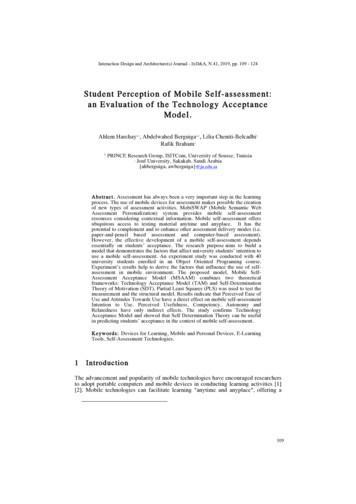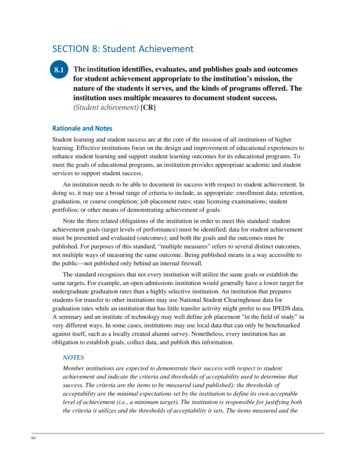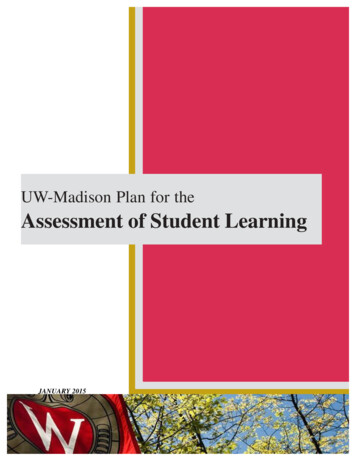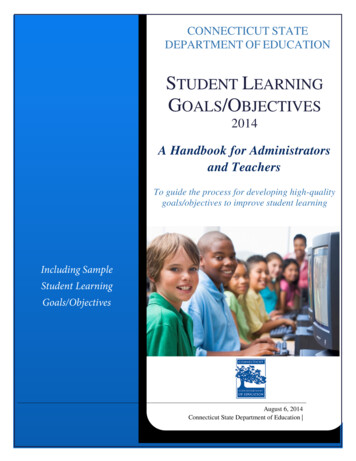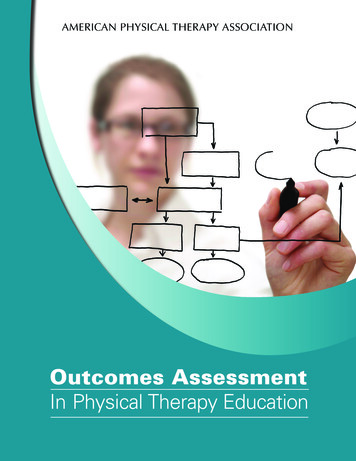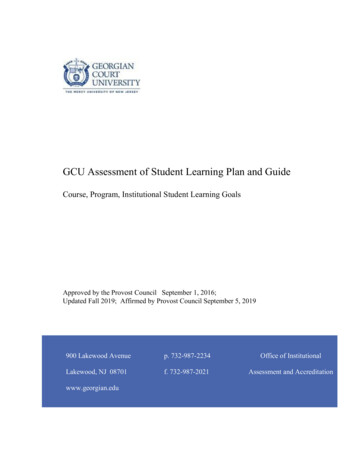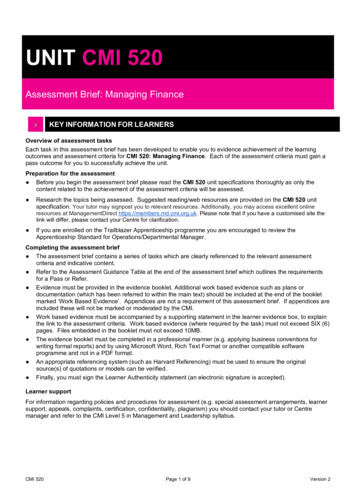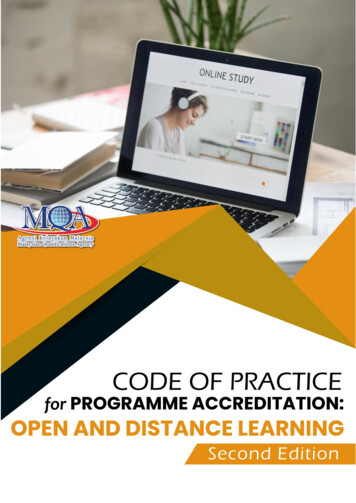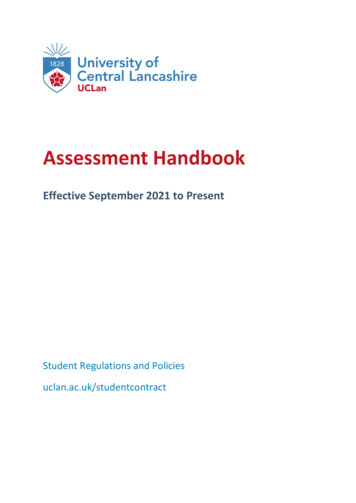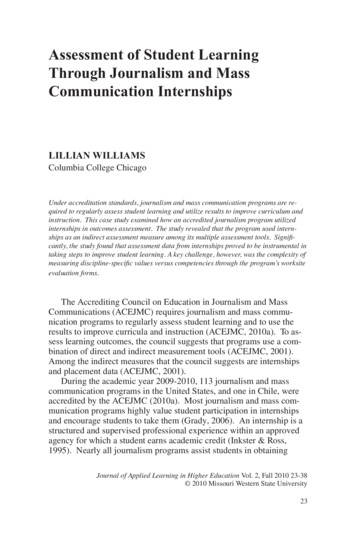
Transcription
Assessment of Student LearningThrough Journalism and MassCommunication InternshipsLILLIAN WILLIAMSColumbia College ChicagoUnder accreditation standards, journalism and mass communication programs are required to regularly assess student learning and utilize results to improve curriculum andinstruction. This case study examined how an accredited journalism program utilizedinternships in outcomes assessment. The study revealed that the program used internships as an indirect assessment measure among its multiple assessment tools. Significantly, the study found that assessment data from internships proved to be instrumental intaking steps to improve student learning. A key challenge, however, was the complexity ofmeasuring discipline-specific values versus competencies through the program’s worksiteevaluation forms.The Accrediting Council on Education in Journalism and MassCommunications (ACEJMC) requires journalism and mass communication programs to regularly assess student learning and to use theresults to improve curricula and instruction (ACEJMC, 2010a). To assess learning outcomes, the council suggests that programs use a combination of direct and indirect measurement tools (ACEJMC, 2001).Among the indirect measures that the council suggests are internshipsand placement data (ACEJMC, 2001).During the academic year 2009-2010, 113 journalism and masscommunication programs in the United States, and one in Chile, wereaccredited by the ACEJMC (2010a). Most journalism and mass communication programs highly value student participation in internshipsand encourage students to take them (Grady, 2006). An internship is astructured and supervised professional experience within an approvedagency for which a student earns academic credit (Inkster & Ross,1995). Nearly all journalism programs assist students in obtainingJournal of Applied Learning in Higher Education Vol. 2, Fall 2010 23-38 2010 Missouri Western State University23
24Journal of Applied Learning in Higher Education / Fall 2010internships because they realize that employers view internships asgood markers of career readiness (Basow & Bryne, 1993). TheACEJMC (2004) also strongly encourages internships and allows programs to grant academic credit when programs supervise and evaluatethese work experiences.Getz (2001) found that not only do students hold positive perceptions about the value of internships, but students believe internshipshelp to validate career choices. Basow and Byrne (1993) reported thatstudents participate in internships for a variety of reasons, including “topractice what they have learned, to acquire new skills, to sample potential careers, to assess their employability, to seek mentoring, and tomake contacts, as well as to earn academic credit or payment” (p. 52).Likewise, Grady (2006) reported that the benefits of internships includerésumé building, enhanced practical knowledge, improvement in writing and production skills, and access to professional-level equipment.Inkster and Ross’s (1995) work, The Internship as Partnership: AHandbook for Campus-Based Coordinators and Advisors, asserts thatthe academic internship coordinator, the worksite supervisor, and theintern represent a “three-person partnership” (p. 12). The agreementshould address learning goals, resources, activities, responsibilities ofthe intern, and criteria for assessing and monitoring the intern’s work(Inkster & Ross, 1995, p. 12).In journalism and mass communication programs, Basow and Byrne(1993) reported academic internship advisers play a key role in the success of internships. These internship advisers often develop contactswith professionals willing to work with student interns, act as coordinators between internship applicants and worksite supervisors, overseethe completion of requirements, and counsel students about career issues (Basow & Byrne, 1993). Grady (2006) suggested that a number ofinternship work requirements could be utilized for evaluative purposes,including the following: Daily or weekly diary, journal, or calendar of eventsDescription or discussion of formal and informal tasks completedReports on books or readings pertinent to employer or type ofworkAUTHOR NOTE: Lillian Williams, Ph.D., Journalism Department, ColumbiaCollege Chicago. The author would like to thank the administrators, faculty,students, staff, site supervisors, and others in this study for their enthusiasticparticipation. Correspondence about this article should be addressed to:Lillian Williams, 600 S. Michigan Avenue, Chicago, IL 60605;E-mail: lwilliams@colum.edu
Williams / ASSESSMENT THROUGH INTERNSHIPS 25Portfolio of work completed during internshipPapers based on interviews with significant personnel in thecompany or organizationFinal report or reflection paperDebriefing session with academic supervisorWorksite supervisor evaluationStudent evaluation of the worksite and internship experience(p. 356)During the 2005-2006 academic year, the ACEJMC (2005) beganto apply the assessment requirement to its accreditation reviews.Assessment of student learning, as defined by Walvoord (2004), is “thesystematic collection of information about student learning, using thetime, knowledge, expertise, and resources available, in order to informdecisions about how to improve learning” (p. 2). Astin (1991) furtherframed it as follows:The role of assessment is to enhance the feedback availableto faculty and staff in order to assist them in becoming moreeffective practitioners. Assessment, in other words, is a technology that educational practitioners can use to enhance thefeedback concerning the impact of their educational practicesand policies. (p. 130)As noted, the ACEJMC (2001) recommends that programs applymultiple assessment measures, including indirect and direct measuresof student learning. Internship supervisor surveys are among theindirect measures that a journalism and mass communication programcould utilize to measure student learning (ACEJMC, 2001). In regardto internships as an indirect measure, the council encourages programsto perform “regular compilation, comparison and analysis over time”(AEJMC, 2001, p. 4) of the numbers and proportions of students whoseek and find internships. The council also recommends that programssystematically analyze evaluations by worksite supervisors and utilizeresults to improve curriculum and instruction (ACEJMC, 2001, p. 4).Other indirect assessment measures for program assessment includegrade distribution; student retention and graduation rates; probationand dismissal data; student performance in local, regional, and national contests; alumni and student surveys, and student exit interviews(ACEJMC, 2001). By comparison, direct measures of student learning include student performance in capstone courses; pretest/posttestevaluations; sectional and department exams; and portfolio evaluations,including student work from professional internships (ACEJMC, 2001).Highlighting how internships also could be utilized as a direct measure
26Journal of Applied Learning in Higher Education / Fall 2010of assessment, Foote (2006) pointed out that employers “are in a position to rate directly the competence of the student and their prospect inthe marketplace” (p. 486), and thus “the rating of individual students’professional performance in a systematic way provides a valuable,direct measure of assessment” (p. 486).Even prior to the creation of the ACEJMC’s assessment standard,however, some journalism and mass communication programs hadutilized internships as a tool for assessment (Graham, Bourland-Davis,& Fulmer, 1997; Vicker, 2002). In a study utilizing narrative accountsby interns, Graham et al. (1997) found, for example, that internshipswere useful in identifying strengths and weaknesses of a public relations program, and that internship feedback provided empirically drivenjustification for program changes (p. 203). Vicker (2002) found thatworksite supervisor evaluations assisted in identifying strengths andweaknesses of a program.In the present study, the four research questions were: (a) Whatspecific learning outcomes are measured through the internship experience in journalism and mass communication? (b) In what ways does theprogram collect data from internship experiences for learning outcomesassessment? (c) In what ways does the program use results from internship assessments to improve the academic experience? and (d) Whatare the challenges to successful implementation of assessment wheninternships are utilized to measure student learning?METHODThis study employed a qualitative, case study design and was conducted at a comprehensive institution that offers more than 40 undergraduate fields of study, including a journalism and mass communication program that is accredited by the ACEJMC. Data were collectedthrough institutional documents (e.g., internship evaluation forms,assessment reports) and 16 face-to-face participant interviews, including interviews with three administrators, three faculty, six students, twoworksite supervisors, and two staff members—the program’s internship director and the university career center experiential educationdirector. Administrator and faculty study participants had worked onassessment issues in the course of their departmental activities; studentparticipants had completed internship experiences; worksite supervisorshad supervised interns from the program; the internship director hadresponsibility for implementing the internship program; and the experiential education director’s office had conducted an attitudinal survey ofstudent interns.In data collection and analysis, the study utilized an interviewstrategy that allowed for open-ended questioning and a conversational
Williams / ASSESSMENT THROUGH INTERNSHIPS27style, but centered on a core group of four specific interview questions.Those interview questions were: a) Identify and describe specific learning outcomes assessed in internships; b) Identify and describe methodsfor assessing student learning outcomes during internships; c) Identifyand describe ways internship data are used to improve curriculum, instruction, and student learning; and d) Identify and describe challengesto implementation of assessment using internship data. The interviewswere conducted on the campus. Participants were requested to signan informed consent statement that indicated that they understood thepurpose of the research, the voluntary nature of their participation, theirright to terminate participation at any time during the study, and assurance of confidentiality related to their participation. Interviews werethe primary source of data, but supplemental sources of data includeda course handbook, assessment report, program self-study report, andinternship evaluation and registration forms. In data analysis, the studyemployed the constant comparative method, an analytical method frequently used in case study educational research (Merriam, 1998).Unites of data were sorted and coded into groupings. Patterns that surfaced became categories, or themes of the study, which were comparedfor relationships and differences.RESULTSSPECIFIC LEARNING OUTCOMES MEASUREDTHROUGH INTERNSHIP EXPERIENCESTwo dominant findings emerged in regard to the specific learningoutcomes measured through internship data. First, the program adoptednine of 11 values and competencies cited in accrediting standards asthe specific learning outcomes measured through internships. Following this study, in the Fall of 2009, the ACEJMC (2009) amended itsstandards, and added to the list of professional values and competenciesthat students should learn and programs should measure. In additionto the values and competencies recommended by the accrediting body,the program also measured general workplace behavioral skills, suchas punctuality and reliability. All learning outcomes were measuredthrough worksite supervisor surveys.This study finding—highlighting the impact of accreditation standards on assessment—was corroborated in other research that demonstrates the growing influence of disciplinary accrediting organizationsover assessment of student learning (Whittlesey, 2005). In the caseunder study, faculty held discussions in which they decided that theACEJMC recommended learning outcomes aligned with key valuesand competencies advocated by the faculty.
28Journal of Applied Learning in Higher Education / Fall 2010The specific learning outcomes measured during assessment were:(a) applying ethical ways of thinking, (b) knowing history and rolesof media, (c) communicating to diverse audiences, (d) writing clearlyand accurately, (e) using technology, (f) applying concepts in presenting information, (g) conducting research and evaluating information,(h) interpreting data and statistics, (i) being creative, and (j) thinkinganalytically.Faculty and staff participants particularly stressed that generalworkplace skills, such as reliability and punctuality, contribute to success and failure in the workplace and should be assessed, in addition tothe discipline-specific values and competencies recommended by theACEJMC. This finding is in alignment with literature recommendingthe measurement of general workplace behavior skills, in addition tothe discipline-specific competencies (Hurd & Schlatter, 2007). Thenine general workplace competencies assessed through internships inthis program were (a) works independently, (b) evaluates work of selfand others, (c) understands law and issues in the workplace, (d) clearpresentation skills, (e) good interpersonal skills, (f) reliability and punctuality, (g) appropriate appearance, (h) takes constructive criticism, and(i) completes work on time.DATA FROM INTERNSHIPSThe second research question examined the ways in which the program collects data from internship experiences for learning outcomesassessment. The study revealed that data were collected through fivemeans: worksite supervisor evaluations of interns, university visits towork sites, direct student feedback, descriptive records, and a surveyof interns. The following discussion offers more detail concerning thisfinding.Worksite supervisor evaluations. Administrators, faculty, andstaff agreed that worksite supervisor evaluations were the most crucialmeans of gathering data for assessment through internship experiences.Worksite supervisor evaluations offer a reality check by an important,external stakeholder group. As one administrator put it, “We havesome internal ways of doing assessment, but this is a nice external way.It involves someone who is not on our payroll.” The importance offeedback from worksite supervisors is reflected in assessment literature suggesting that such measurements by employer supervisors offeran opportunity “for feedback and curricular change with a cycle timethat can address rapidly changing employer needs and expectations”(Brumm, Hanneman, & Mickelson, 2006, p.127).Direct student feedback. Though all study participants acknowledged the importance of employer feedback, faculty study participants
Williams / ASSESSMENT THROUGH INTERNSHIPS29repeatedly underscored the value of another type of feedback—thedirect feedback to faculty from students returning from their internships. This finding is in alignment with assessment literature (Beard,2007), which suggests that post-internship discussions with studentswith regard to outcomes can impact both curricular, and teaching andlearning strategies. In the present study, faculty felt that direct conversations with students allowed them to pose follow-up questions aboutinternship experiences and to confirm or disaffirm classroom teaching/learning tactics. Faculty also found that this direct student feedbackopened the gateway for worksite supervisors to interact even furtherwith students and faculty, in the form of speaking engagements andother activities. A faculty participant illustrated this finding:I will debrief all of my students about their internships becauseI want to know what’s going on in the business. What arenews directors saying? What reinforces what I’m saying in theclassroom? What counters what I’m saying in the classroom?What’s new in the business? You thought your news directorwas brilliant. Do you think she’ll come and talk to our class?Worksite visits. Inkster and Ross (1995) reported that visits tointernship work sites offer an excellent opportunity to see interns inaction and to observe their interactions with others. At the programunder study, visits to internship work sites were another way that theprogram collected data for assessment purposes. Although site visitsby the program were sporadic during the assessment cycle under study,participants reported that these visits allowed the program to observeinternship performance and reactions to performance at the work site.Study participants reported that these observations helped the programto affirm firsthand how skills and competencies are demonstrated at thework sites.Intern survey. Students reported that a confidential online surveyadministered by the college offered them yet another way to give feedback about their internship experiences. The survey queried studentsabout career and learning-related issues, including connections theyperceive between knowledge gained in the classroom and worksite expectations. One student described the benefits of such a survey: “Doingan internship, you’re not in the classroom. So, the survey was helpful,as far as getting that information about our internships out to everyone.It was a good idea.”The literature reveals that student surveys are appropriate to utilizeas indirect sources of information about factors that may “contribute toor detract from student learning” (Lopez, 2002, p. 361) but should notbe substituted for direct measurements of student learning. As Lopez
30Journal of Applied Learning in Higher Education / Fall 2010(2002) explained, student surveys “provide only participants’ opinionson how much they have learned” (p. 361), though such informationcould be useful when triangulated with data from other measures oflearning.Descriptive records. In the program under study, descriptiverecords, such as the types and numbers of internships, were systematically analyzed and maintained in assessment records (see Tables 1and 2).Table 1Table1. Internships/WorkExperiences/CreditHoursfor Schoolof s/CreditHoursfor Schoolof edit work 311263313370119045111151100110150894656229Credit hour experiences071172251ASSESSMENT THROUGH3INTERNSHIPS420Source: 2005 Program Assessment ReportSource:Table2 2005 Program Assessment ReportInternship/WorkExperiencesby Sitefor Winter/Spring2005Table2. Internship/WorkExperiencesbyCategorySite Categoryfor Winter/Spring2005Internship/work experiencePercentageTelevision station or network28%Nonprofit organization (PR/advertising, media relations/marketing)15%For-profit company (PR/advertising, media relations/marketing)13%Newspaper11%Sports team or conference (PR/advertising, media relations/marketing)11%Video/TV production/distribution7%Radio station or network4%Magazine4%Book publishing company4%Audio/music ent ReportSource:2005 ProgramAssessmentReportAdministrators described descriptive records as another method by which the programcollects data for assessment purposes. According to administrators, these data provide anopportunity to observe trend lines reflecting student access to internship opportunities and13
Williams / ASSESSMENT THROUGH INTERNSHIPS31Administrators described descriptive records as another method bywhich the program collects data for assessment purposes. According toadministrators, these data provide an opportunity to observe trend linesreflecting student access to internship opportunities and changes in thejournalism and mass communications employment fields.The assessment literature acknowledges that academic programsgather such descriptive data, but the literature (Lopez, 1997) also describes these data as “non-measures” (p. 15) that do not offer evidenceof student learning. Administrators of this program also recognizethat descriptive data do not offer evidence of student learning, butthey believe these descriptive data are useful for spotting trend lines ininternship opportunities and employment.WAYS THE PROGRAM USES ASSESSMENT RESULTSThe third research question examined the ways that the programutilized results from internship assessments to improve the academicexperience. Assessment research (Nichols, 1995) has argued that to“close the loop” (p. 50), or to use the results of the assessment to takeaction to improve the program, is the bottom line of assessment. Thisresearch showed that the program under study utilized internshipassessment data to make changes designed to improve the academicexperience. In summary, the program utilized internship assessmentresults in the following specific ways: to strengthen ties with worksitesupervisors, to contribute to discussions leading to a new course, toupdate weekly journal assignments, to stimulate conversations aboutstudent learning, and to validate teaching and learning strategies. Thefollowing discussion offers more detail concerning this finding.Strengthen ties with internship worksite supervisors. The studyfound that programs made a decision to strengthen ties with internshipworksite supervisors, rather than restrict access to internships, afterexamining survey data from internships. A survey, administered by thecollege, found that only 60% of interns said they felt prepared for theirinternships. Administrators speculated that students might naturallyfeel intimidated in a new work setting. Or, as an alternate explanation,sophomore-level interns who responded to the survey might feel inadequate because they had not yet taken upper-level courses. Because theprogram encourages students to do multiple internships, program administrators decided to continue the practice of access to internships forsophomore-level students too, but to work more closely with worksitesupervisors to match students to appropriate internships.Contribute to discussions about a new writing course. In anotheraction stemming from assessment, a new writing course was created forcorporate communications students. The research reveals that this
32Journal of Applied Learning in Higher Education / Fall 2010action came after two events: First, a faculty member heard from interns that some students felt unprepared for writing assignments at theirinternship worksites; and second, during a series of meetings aboutassessment, the faculty uncovered a gap in writing instruction. As aresult, the faculty decided to create a new writing course for one of itsconcentrations.Update weekly journal writing assignments. The study showedthat another action resulting from assessment was the decision to keyquestions on internship journal-writing assignments to the professionalvalues and competencies cited in the assessment plan. During discussions about assessment data, administrators noticed that discipline-specific values and competencies were being measured through worksitesupervisor evaluations, but they were not being examined throughquestions in the journal-writing assignments for interns. As a result ofassessment, the program began to include questions about disciplinespecific values and competencies in the internship writing assignments.Stimulate conversations about student learning. The programutilized assessment results to stimulate conversations about studentlearning. Administrators and faculty believed that an importantoutgrowth of assessment through internships, as well as through otherassessment measures, is the conversation it stimulates about studentlearning. Study participants believe that assessment has spurredimportant discussions about student learning. Offering an example,the internship director recalled conversations at one work site in whichan employer suggested additional learning outcomes that the programshould address. Upon returning to the institution, the internship director passed along this feedback to an individual faculty member. Theinternship coordinator also decided to address this and other internshipfeedback with faculty at an appointed time each year, either at the annual faculty retreat or another appropriate venue.Validate classroom instructional approaches. Finally, this studyrevealed that faculty participants utilized assessment results to validateclassroom instructional approaches. In other words, faculty participantsreported that assessment results helped them to reflect on teaching/learning strategies. The assessment literature (Beard, 2007) also arguesthat faculty and students benefit from the integration of internship feedback into classroom activities. In the present study, faculty participantsreported that they compared feedback about intern experiences withtheir teaching/learning goals. As one faculty member put it, “I look atwhat I am doing in my classes, my organizational communication, mytelevision production, or whatever it is I am doing, and how it is in linewith what they were expected to do.”
Williams / ASSESSMENT THROUGH INTERNSHIPS33CHALLENGES ENCOUNTERED WITH ASSESSMENTThe fourth research question in this study investigated the challenges to successful implementation of assessment when internships areutilized to measure student learning. Three key challenges surfaced: (a)complexity involved in measuring values versus competencies throughworksite supervisor evaluation forms; (b) wide variance of internshipsin location, nature, and type; and (c) absence of timely feedback duringinternships. The following discussion offers more detail concerningthese findings.Complexity of Measuring Values. A key challenge encountered inassessment was the complexity of measuring professional values versuscompetencies through worksite supervisor evaluation forms. The program defined professional values as ways of thinking about issues suchas truth, accuracy and fairness, and ethical habits of thinking. Professional competencies included such issues as the ability to write clearlyand accurately and the use of technology. Perplexingly, nearly onethird of the worksite supervisors in the assessment cycle under study responded that two of three values questions on the internship evaluationform were not applicable to their interns. Even prior to the assessmentcycle under study, the academic program had already experiencedsimilar difficulties with responses to the internship evaluation form and,as a result, had deleted two other values questions from the evaluation form for interns. Said one administrator, “It seemed reasonable toconclude that many supervisors did not feel comfortable evaluating orthought questions about these values were not applicable to their workenvironment.”A worksite supervisor and another administrator study participantpondered yet another explanation: Perhaps the questions on the evaluation form needed to be clarified. As the administrator put it,We hope that the instrument is clear in the way that it’sformulated. I don’t know that we know that completely, butI think the questions on the evaluation instrument are fairlystraightforward and clear. It could be that we could do abetter job of describing for each employer what thosequestions really mean.The complexity of measuring values is cited in psychology literature, which argues that values cannot be measured directly, but rathercan only be inferred from what a person says or does (Domino &Domino, 2006, p. 141). One worksite supervisor in the present studyexplained the difficulty in measuring values, saying, “Obviously it’seasier for me to see that this person can write or spell,” but harder to
34Journal of Applied Learning in Higher Education / Fall 2010evaluate that person’s values. That sentiment was echoed by an administrator participant as well. “So, it’s not a perfect match,” the administrator study participant concluded, adding,It seemed to actually work better with competencies becausesupervisors know if that intern was a good writer or not, or ifthe intern understands technology or not, or seems to showthat they can think critically or creatively. So, we found thatour instrument feedback on internships fit the competenciesbetter than the values.Wide Variety of Internships. Program administrators consideredyet another challenge of utilizing internships in assessment: the difficulty of collectively analyzing assessment results from such a widevariety of journalism and mass communications internships. In theprogram under study, all students were required to participate in eitheran internship for credit, or a non-credit professional work experience.Internship experiences in the program under study varied extensively inlocation, nature, and type. The type of work sites ranged, for example,from newspapers and television stations to book publishing and musicproduction. As one administrator put it,[Internships are] difficult to compare. Therefore, the kinds ofquestions, and the kinds of assignments that we create in anattempt to get at [student learning], must be very general innature. The best we can do is generalize about the experiencesoverall, and that’s what we’re trying to do.Administrator participants in this study, however, concluded thatthey gleaned valuable information for assessment purposes frominternships. They decided that information from these diverse worksettings—collected and analyzed over time—could help to detect trendlines in internship opportunities and the employment field.Lack of Timely Feedback. A third challenge the study revealedwas the lack of real-time feedback from interns at their work sites. Thisstudy showed that results of internship experiences are reporte
however, some journalism and mass communication programs had utilized internships as a tool for assessment (Graham, Bourland-Davis, & Fulmer, 1997; Vicker, 2002). In a study utilizing narrative accounts by interns, Graham et al. (1997) found, for example, that internships were useful in identifying strengths and weaknesses of a public rela-

